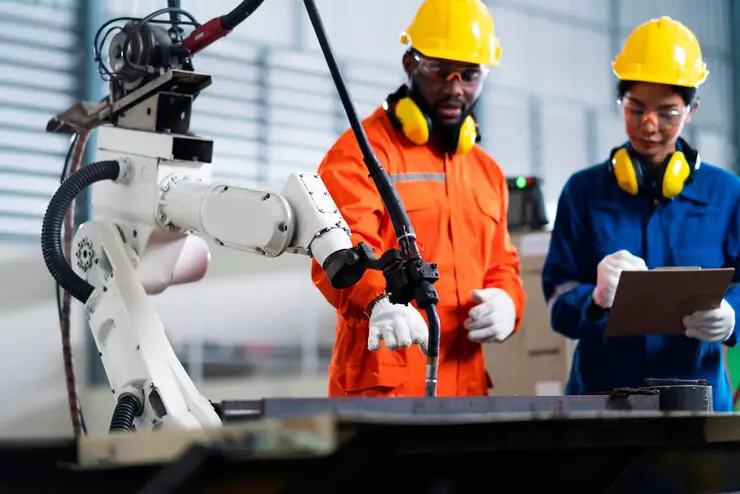Introduction: The Power of Automation and Robotics
Automation and robotics are transforming industries and daily life at an unprecedented rate. From manufacturing efficiency to advancements in healthcare, these technologies have become integral in optimizing human work. But what is the true impact of automation and robotics on our world? Let’s explore.
The Evolution of Automation
Automation has evolved significantly since its inception, beginning as simple mechanical systems and blossoming into highly advanced technologies.
Early Forms of Automation
The journey of automation began centuries ago with inventions like water wheels and windmills. These devices paved the way for the more complex systems we have today.
The Industrial Revolution: Birth of Mechanization
The Industrial Revolution was a major turning point. Machines began replacing human labor in factories, ushering in a new era of increased production and efficiency. This laid the foundation for modern automation.
What Is Robotics?
While automation refers to systems working with minimal human intervention, robotics takes it further by creating autonomous machines capable of complex tasks.
What Defines a Robot?
Robots are programmable machines that perform tasks independently. These can range from simple cleaning robots to complex, humanoid robots with advanced AI.
Key Components of Robots
Robots consist of sensors, actuators, and control systems that enable them to interact with their environment, make decisions, and carry out tasks effectively.
Automation and Robotics: A Perfect Pair
Automation and robotics complement each other seamlessly, creating systems that improve efficiency and precision.
How Automation and Robotics Work Together
In industries like manufacturing, robots automate repetitive tasks, ensuring consistent quality and reducing errors. This synergy creates faster production processes.
Real-Life Examples of Robotic Automation
Robotic automation is everywhere—from automotive assembly lines to Amazon’s fulfillment centers, where robots sort and move products with unparalleled speed and accuracy.
Automation’s Impact on Manufacturing
Automation has become a cornerstone in modern manufacturing, improving productivity and safety.
Streamlining Production Lines
Robotic arms and other automated systems work tirelessly on production lines, performing tasks that humans find tedious or dangerous, increasing overall efficiency.
The Rise of Collaborative Robots (Cobots)
Cobots are revolutionizing the workplace by working alongside human employees, assisting in tasks that combine human intelligence with robotic precision.
Robotics in Healthcare: Enhancing Precision and Care
Robots in healthcare are playing pivotal roles, from surgery to patient assistance.
Surgical Robots and Precision Medicine
Surgical robots allow doctors to perform delicate procedures with extreme precision, leading to faster recovery times and better outcomes for patients.
Robots in Patient Care
In hospitals and care facilities, robots assist with lifting patients, delivering medications, and even providing companionship, alleviating the workload on healthcare professionals.
Automation in the Service Industry
The service industry is increasingly turning to automation to improve customer experience and efficiency.
Automated Customer Service Systems
AI-powered chatbots provide 24/7 customer support, resolving simple issues instantly and allowing human agents to focus on more complex tasks.
Self-Checkout Systems in Retail
Retailers use self-checkout systems to streamline the shopping experience, reducing wait times and freeing staff for other roles.
The Future of Work: Human-Robot Collaboration
Automation and robotics are reshaping the workplace. But instead of replacing humans, they are likely to work alongside us, enhancing productivity.
Will Robots Replace Human Jobs?
While robots may replace some repetitive roles, they will also create new opportunities in fields like AI development, robotics maintenance, and tech innovation.
Human-Robot Collaboration
Robots and humans working together is the future of work. By handling mundane tasks, robots allow us to focus on creativity, problem-solving, and strategic thinking.
Ethical Considerations: Challenges and Opportunities
With the rise of automation and robotics come ethical dilemmas, especially around job displacement and privacy.
Job Displacement
While automation may lead to some job losses, it also opens new avenues in tech and innovation. Society must find ways to retrain and upskill workers to prepare for the shift.
Privacy Concerns
Robotic surveillance raises concerns about privacy. As robots collect and process more data, we must ensure safeguards are in place to protect personal information.
AI and Machine Learning: The Brains Behind Automation
AI and machine learning are critical to the success of autonomous robots, enabling them to adapt and improve.
AI in Autonomous Robots
AI allows robots to learn from their environment and make decisions without constant human oversight, making them more efficient and adaptive.
Machine Learning’s Impact
With machine learning, robots become better at their tasks over time, allowing them to handle more complex and dynamic environments.
The Future of Automation and Robotics
The future holds incredible possibilities for automation and robotics, from smart factories to space exploration.
Smart Factories and Industry 4.0
Smart factories, where robots and automated systems are interconnected, will revolutionize manufacturing. These factories will self-optimize, increasing productivity and reducing waste.
Robotics in Space Exploration
Robots are crucial for space missions, exploring environments that are too dangerous for humans, conducting experiments, and collecting valuable data.
Challenges Facing Robotics
Despite the advances, robotics still faces technological and regulatory challenges.
Technological Limitations
Robots face challenges such as limited battery life and processing power, which hinder their ability to operate autonomously for long periods.
Regulatory and Legal Hurdles
Governments and regulatory bodies are still determining how to govern robotic technologies, especially in areas like autonomous vehicles and drones.
The Economic Impact of Automation and Robotics
Automation and robotics are reshaping economies worldwide by increasing productivity, but there are also concerns about inequality.
Increased Productivity
Robotic systems allow businesses to produce more with fewer resources, driving economic growth and allowing for more efficient use of labor.
Economic Inequality
While automation boosts efficiency, it may widen the gap between high-skill and low-skill workers. Ensuring access to education and retraining programs is essential to mitigate this impact.
Sustainability and Robotics: A Green Future
Automation and robotics are playing a key role in creating sustainable solutions for the future.
Energy-Efficient Robotic Systems
Many modern robots are designed to be energy-efficient, reducing power consumption and minimizing their carbon footprint.
Robotics in Environmental Conservation
Robots are increasingly being used for environmental conservation, such as monitoring wildlife, cleaning up oceans, and supporting reforestation efforts.
Conclusion: The Road Ahead
Automation and robotics are rapidly transforming industries and everyday life. While there are challenges, the future looks promising, with robots working alongside humans to create a more efficient, sustainable, and innovative world. The key is to navigate the ethical, technological, and economic implications to ensure a balanced and equitable future for all.
FAQs
1. Will robots take over all jobs?
Not all jobs. Robots will take over repetitive and dangerous tasks, but many jobs will remain human-centered, focusing on creativity, problem-solving, and leadership.
2. What is a collaborative robot (cobot)?
Cobots are robots designed to work alongside humans, assisting in tasks that require both human judgment and robotic precision.
3. Are robots used in healthcare?
Yes, robots are increasingly being used in healthcare for tasks such as surgery, patient care, and even companionship in elder care facilities.
4. How does AI power automation?
AI powers automation by enabling machines to learn from their environment, make decisions, and adapt to new challenges without constant human oversight.
5. What industries are most affected by automation?
Industries such as manufacturing, healthcare, retail, and service sectors are seeing significant transformation through automation and robotics.
Conclusion:
Automation and robotics are revolutionizing industries and reshaping the future of work. While they offer immense benefits like increased efficiency and innovation, they also pose challenges such as job displacement and ethical considerations. The key to moving forward is embracing these technologies responsibly, ensuring they work alongside humans to create a more efficient, sustainable, and equitable future for all.


